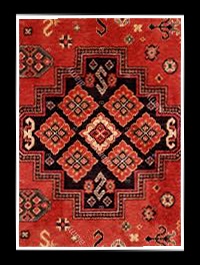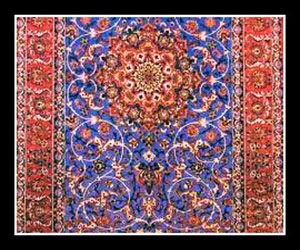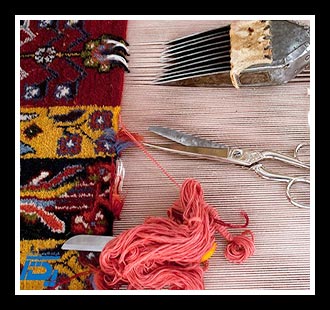History of the Persian Carpet:

The history of Carpet in Iran is a world of artistic impressiveness nurtured for more than 2,500 years. The Iranians were among the first carpet weaver of the ancient civilizations and, through centuries of creativity and ingenuity building upon the talents of the past, reached a unique degree of excellence. Russian archaeologists in 1949 discovered the oldest known carpet in the Pazyryk valley, about 5000 feet up on the Altai Mountains in Siberia. The Pazyryk carpet is of rare beauty and woven with great technical skill.
The first documented evidence on the existence of Persian carpets came from Chinese texts dating back to the Sassanid period (224 – 641 CE). There is, though, in Greek historiography earlier written evidence on the existence, value, and quality of Persian carpets.
The art of Persian carpet underwent many changes in various eras of the Iranian history to an extent that it passed an upward trend before the Islamic era until the Mongols invasion of Iran. After the invasion, the art began to grow again during the reign of the Mongol dynasties of Timurid and Ilkhanid.
With the passage of time, the materials used in carpets, including wool, silk and cotton.
Therefore archaeologists are rarely able to make any particularly useful discoveries during archaeological excavations. Such fragments do not help very much in recognizing the carpet-weaving characteristics of pre-Seljuk period (13th and 14th centuries AD) in Persia.
Historical records show that the Achaemenian court of Cyrus the Great at Pasargadae, was decked with magnificent carpets. This was over 2500 years ago. Alexander II of Macedonia is said to have been dazzled by the carpets in the tomb area of Cyrus the Great at Pasargadae.
By the sixth century, Persian carpets of wool or silk were renowned in court circles throughout the region. The Bahârestân carpet of Khosrow was made for the main audience hall of the Sasanians imperial Palace at Ctesiphon in Sasanian province of Khvârvarân. It was 140 m long and 27 m wide and depicted a formal garden.
According to historians, the famous Tāqdis throne was covered with 30 special carpets representing 30 days of a month and four other carpets representing the four seasons of a year. When Cyrus the Great conquered Babylon in 539 BC, he was struck by its splendor, and it was probably he who introduced the art of carpet making into Persia. However, historical records show that magnificent carpets adorned the court of Cyrus the Great, who founded the Persian Empire over 2,500 years ago.
The tomb of Cyrus who was buried at Pasargadae near Persepolis, was covered with precious carpets. Even before his time, it is very likely that Persian nomads knew about the use of Knotted carpets. Their herds of sheep and goats provided them with high quality and durable wool for this purpose.
In 628 CE, the Emperor Heraclius brought back a variety of carpets from the conquest of Ctesiphon, the Sassanian capital. The Arabs also conquered Ctesiphon in 637 CE, and among the spoils brought back were said to be many carpets, one of which was the famous garden carpet, the “spring time of Khosro”. This carpet has passed into history as the most precious of all time. Made during the reign of Khosro I (531 – 579 CE) the carpet was 90 Feet square.
The Arab historians’ description is as follows: ” The border was a magnificent flower bed of blue, red, white, yellow and green stones; in the background the color of the earth was imitated with gold; clear stones like crystals gave the illusion of water; the plants were in silk and the fruits were formed by color stones”. However, the Arabs cut this magnificent carpet into many pieces, which were then sold separately.

In the 8th century A.D. Azerbaijan Province was among the largest centers of carpet and rough carpet weaving in Iran. The Province of Tabarestan, besides paying taxes, sent 600 carpets to the courts of caliphs in Baghdad every year. At that time, the main items exported from that region were carpets, and small carpets for saying prayers. Furthermore, the carpets of Khorassan, Sistan and Bukhara, because of their prominent designs and motifs were on high demands among purchasers.
During the reigns of the Seljuk and IL khanate dynasties, carpet weaving was still a booming business so much so that a mosque built by Ghazan Khan in Tabriz, northwestern Iran, was covered with superb Persian carpets. Sheep were specially bred to produce fine wool for weaving carpets.
Carpet designs depicted by miniature paintings belonging to the Timurid era lend proof to the development of this industry at that time. There is also another miniature painting of that time available which depicts the process of carpet weaving.
The earliest surviving of the Persian carpets from this period is of a Safavid carpet known as the Ardabil Carpet, currently in V&A Museum in London. There is much variety among classical Persian carpets of the 16th and 17th century.
There are numerous sub-regions that contribute distinctive designs to Persian carpets of this period such as Tabriz and Lavar Kerman. Common motifs include scrolling vine networks, arabesques, cloud bands, medallions, and overlapping geometric compartments rather than animals and humans. Figural designs are particularly popular in the Iranian market and are not nearly as common in carpets exported to the west.
The period of Seljuk was of great importance in the history of Persian carpets. The Seljuk women were skilful carpet makers using Turkish knots. In the provinces of Azerbaijan and Hamadan where Seljuk influence was strongest and longest lasting, the Turkish knot is used to this day.
In the Turkish knot the yarn is taken twice around two adjacent warp threads and the ends are drawn out between these two threads. And in the Persian Knot, the wool thread forms a single turn about the warp thread. One end comes out over this thread and the other over the next warp thread.
The Mongol conquest and control of Persia was initially brutal. However, they soon came under the influence of the Persians. The palace of Tabriz, belonging to the IL khan leader, Ghazan Khan had paved floors of the palace covered with valuable carpets.
The Mongol ruler Shah Rokh contributed to the reconstruction of much that was destroyed by the Mongols and encouraged all the artistic activities of the region. However, the carpets in this period were decorated with simple motifs, which were mainly geometric in style.
The Persian carpet reached its zenith during the reign of the Safavid Dynasty in the 16th century. Indeed the first concrete proofs of this craft date back to this period. Approximately 1500 examples are preserved in various museums and in private collections worldwide. Shah Abbas encouraged contacts and trade with Europe and transformed his new capital Esfahan, into one of the most glorious cities of Persia. He also created a court workshop for carpets where skilled designers and craftsmen set to work to create splendid specimens.
Most of these carpets were made of silk, with gold and silver threads adding even more embellishment. Two of the best know carpets of the Safavid period; come from the mosque of Ardebil. Many experts believe that these carpets represent the culmination of achievement in carpet design. The larger of the two Iranian carpets in now kept in London’s Victoria and Albert Museum while the other is displayed at the Los Angeles County Museum.
The Afghan invasion in 1722. The Afghans destroyed Esfahan, yet their domination lasted for only a short period and in 1736, a young Chieftain from Khorasan, Nader Khan became the Shah of Persia. During this period, and for several turbulent years after his death in 1747, no carpets of any great value were made, and solely nomads, and craftsmen in small villages continued the tradition of this craft.
In the last quarter of the 19th Century and during the reign of the Qajar ruler’s trade and craftsmanship regained their importance. Carpet making flourished once more with Tabriz merchants exporting carpets to Europe through Istanbul. Most of the problems facing this traditional art is due to absence of patenting and branding the products as well as reduced quality of raw materials in the local market and the consistent loss of original design patterns.
Wool is the most common material for Iranian carpets but cotton is frequently used for the foundation of city and workshop carpets. There are a wide variety in types of wool, which include Kork wool, Manchester wool, and in some cases even Camel Hair wool.
Silk carpets date back to at least the sixteenth century in Sabzavar and the Seventeenth century in Kashan and Yazd silk carpets are less common than wool carpets since silk is more expensive; they tend to increase in value with age. Due to their value and lack of durability, silk carpets are often displayed on the wall.
Iranian carpet are made up of a layout and a design which in general included one or a number of motifs. They are typically designed using one of three patterns: all-over, central medallion and one-sided. Some abstract unsymmetrical design can be found but most of these can be described as one-sided or unidirectional.
There are a number of patterns which are found in Persian and Oriental rugs called ‘motifs’, these designs have different meanings and tend to be used depending on the area the rug was woven although it is not unusual to find more than one motif in a single rug.
To begin making a rug, you need a foundation consisting of warps strong, thick threads of cotton, wool or silk which run the length of the rug and wefts similar threads which pass under and over the warps from one side to the other.

The Persian knot is used for finer rugs. The yarn is wrapped around only one warp, then passed behind the adjacent warp so that it divides the two ends of the yarn. The Persian knot may open on the left or the right, and rugs woven with this knot are generally more accurate and symmetrical.
Flat woven carpets are given their color and pattern from the weft which is tightly intertwined with the warp. Rather than an actual pile, the foundation of these rugs gives them their design. The weft is woven between the warp until a new color is needed, it is then looped back and knotted before a new color is implemented.
The Persian Carpet weaving is most widespread handicraft in Iran. Iranian handmade carpet is renowned for their richness of color, variety of spectacular artistic patterns and quality of design. In palaces, famous buildings, mansions and museums of the world, an Iranian carpet is amongst the most treasured possession.
© Fa.asadi Artwork Collection.
